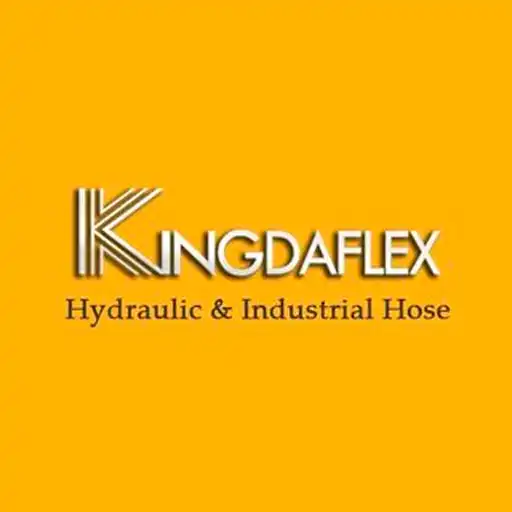Hydraulic hoses are essential components in industrial and automotive systems, ensuring efficient fluid transfer under high pressure. Among the most common hydraulic hose types are spiral and braided hydraulic hoses. Understanding their differences in construction, pressure ratings, and flexibility is crucial for selecting the right hose for your specific application, ensuring optimal performance and safety.
Spiral and braided hydraulic hoses may appear similar, but their internal structure and performance characteristics vary significantly. Spiral hoses offer higher pressure tolerance and durability, while braided hoses provide greater flexibility and ease of installation. Knowing these differences helps engineers, technicians, and buyers make informed choices for industrial, construction, or automotive hydraulic systems.
What Is A Spiral Hydraulic Hose?
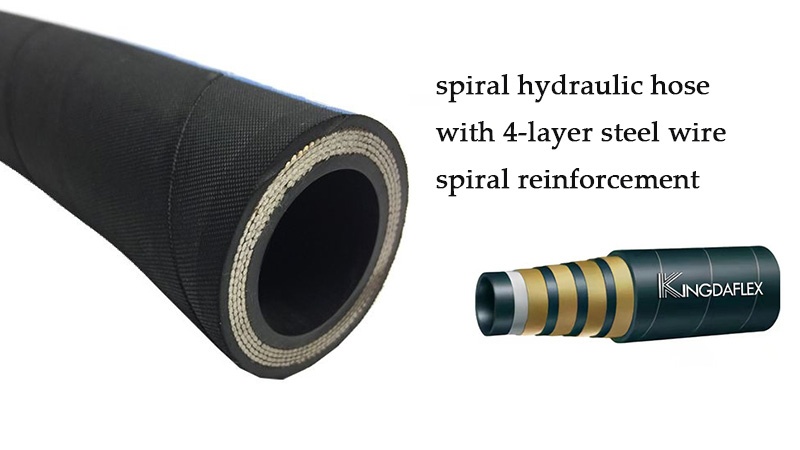
Spiral hydraulic hoses are high-pressure hoses designed with multiple layers of steel wire reinforcement arranged in a spiral pattern. This construction allows them to handle extremely high pressures while maintaining flexibility. They are commonly used in heavy-duty industrial, construction, and mobile hydraulic applications.
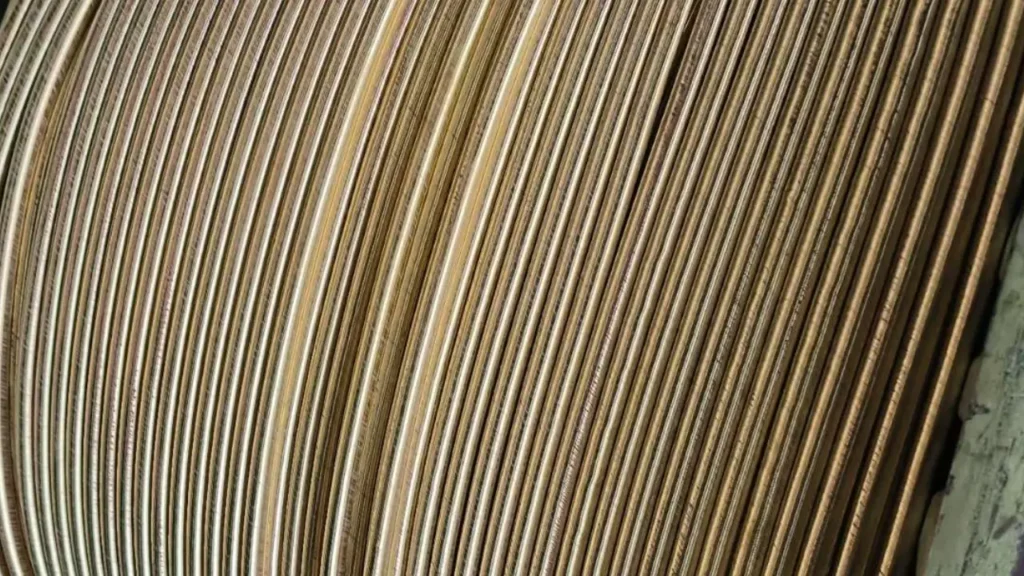
- High Pressure Resistance: Spiral hydraulic hoses are engineered to withstand very high operating pressures, making them suitable for demanding hydraulic systems in construction machinery, industrial presses, and mining equipment where reliability under pressure is critical.
- Durability and Strength: The spiral steel wire reinforcement provides excellent durability and strength, preventing hose collapse under vacuum and resisting wear, abrasion, and harsh environmental conditions for long-lasting performance.
- Flexibility: Despite their heavy-duty design, spiral hoses offer sufficient flexibility for installation in tight spaces or complex hydraulic circuits, allowing smooth bends without compromising pressure ratings or structural integrity.
- Temperature Tolerance: These hoses can operate efficiently across a wide temperature range. Their construction resists heat from hydraulic fluid and cold outdoor environments, ensuring safe operation in various climates and industrial conditions.
- Applications: Spiral hydraulic hoses are ideal for mobile equipment, industrial machinery, and high-pressure fluid transfer systems. They ensure reliable, leak-free performance in environments where safety, durability, and efficiency are paramount.
What Is A Braided Hydraulic Hose?
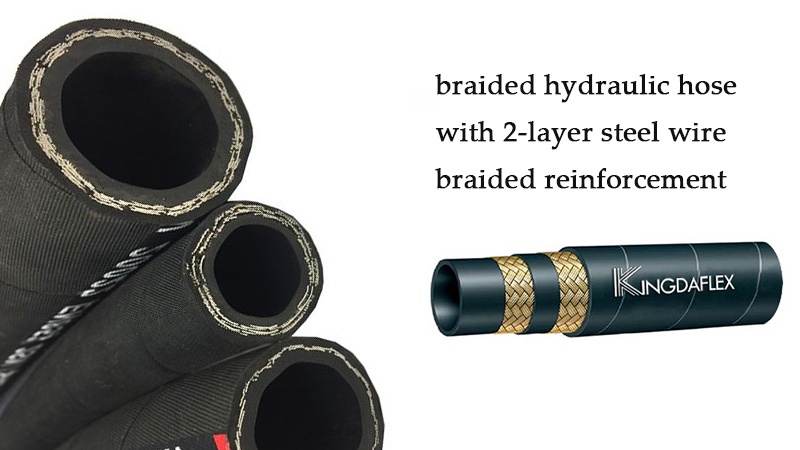
A wire braided hydraulic hose consists of braided and woven high tensile steel wires overlapping one another to reinforce the tube. Our hydraulic hose manufacturer will use the advanced hydraulic hose braiding machine to braid the steel wire to create the braided reinforcement for the hydraulic hose.
And the hydraulic hose braiding machine will perform the braiding task to create braiding steel wire reinforcement during the manufacturing process, to produce the stainless steel braided hydraulic hose. And the braided hydraulic hose can increase the burst resistance to the hydraulic hose tube, and also add more flexibility to the hose pipe.
A braided hydraulic hose is a flexible conduit reinforced with braided wire layers, designed to transfer hydraulic fluids under moderate to high pressure. Its construction combines flexibility, strength, and durability, making it ideal for industrial, automotive, and machinery applications where maneuverability and reliability are essential.
- Construction: Braided hoses consist of an inner tube for fluid transfer, a braided wire layer for reinforcement, and an outer protective cover. This design balances strength and flexibility, allowing hoses to handle pressure while bending around equipment and tight spaces without kinking or damage.
- Pressure Handling: Braided hydraulic hoses are engineered to handle moderate to high-pressure levels, making them suitable for various hydraulic systems. The braided reinforcement distributes pressure evenly, preventing leaks and maintaining safe, efficient fluid flow under demanding operational conditions.
- Flexibility: These hoses offer excellent flexibility compared to spiral hoses. Their braided structure allows easy installation in complex machinery layouts, tight spaces, and moving equipment, ensuring reliable performance without compromising bend radius or system integrity.
- Durability: Braided hydraulic hoses resist wear, abrasion, and environmental factors, including chemicals, heat, and UV exposure. This durability ensures long service life and minimizes maintenance, making them a cost-effective choice for continuous industrial and automotive use.
- Applications: Commonly used in mobile equipment, construction machinery, and automotive hydraulic systems, braided hoses provide reliable performance for fluid transfer, control systems, and machinery operations where flexibility and pressure handling are critical.
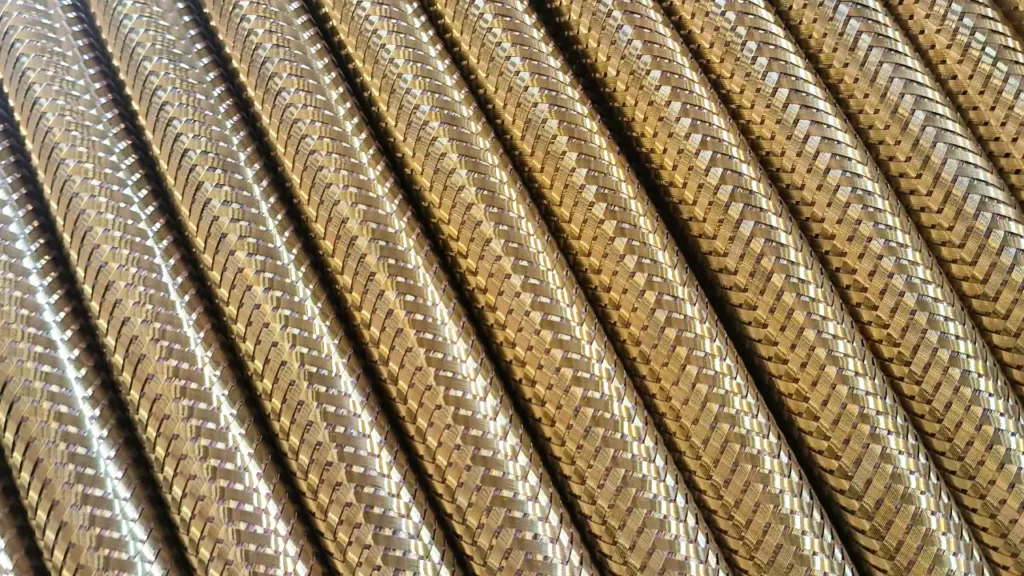
The steel braided hydraulic hose consists of braided steel wire to add much more strength to the whole hydraulic hose, making it much more durable and solid.
Here we have multiple choices for you to choose the steel braided hydraulic hose reinforced with different layers of steel wire. The more braided steel wire can add more strength to the hydraulic hose pipe.
And the crisscrossing braided wire reinforcement can make the hydraulic hose become more flexible, much easier to bend compared with a spiral hydraulic hose.
Spiral vs Braided Hydraulic Hose
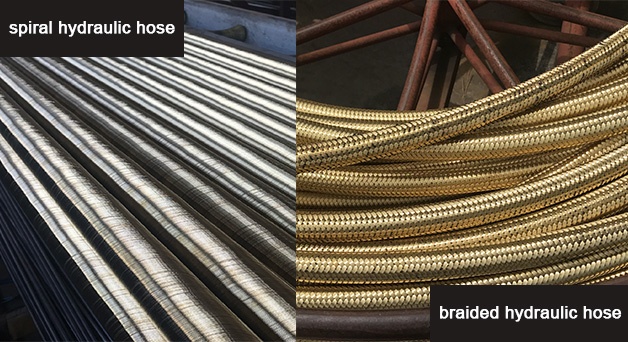
Spiral and braided hydraulic hoses are commonly used in industrial and automotive systems. Their construction, pressure capacity, and flexibility differ significantly, making each suitable for specific applications. Understanding these differences helps in selecting the right hose for safety and efficiency.
Construction
Spiral hoses feature multiple layers of steel wire wound in a spiral pattern around the inner tube, providing high strength and pressure resistance. This design makes them ideal for heavy-duty, high-pressure hydraulic systems in industrial and construction applications.
Braided hoses consist of one or more layers of braided steel wire reinforcement over a flexible inner tube. This structure balances flexibility and moderate pressure resistance, allowing easier routing in tight spaces and machinery with complex layouts.
Pressure Rating
Spiral hoses are designed to handle extremely high pressures, often exceeding braided hoses. They are suitable for hydraulic systems where maximum pressure tolerance is critical, ensuring reliable performance in demanding environments.
Braided hoses have lower pressure ratings compared to spiral hoses. They are ideal for moderate-pressure systems, providing adequate strength while maintaining flexibility, making them suitable for automotive or light industrial machinery.
Flexibility
Spiral hoses are less flexible due to their tightly wound wire layers. While extremely strong, they require careful handling and installation, making them better suited for straight or minimally bent hydraulic lines.
Braided hoses offer superior flexibility, allowing them to bend easily around obstacles and fit into compact or complex machinery setups. This makes them easier to install and maintain in restricted spaces.
Durability
Spiral hoses excel in heavy-duty durability, resisting abrasion, high pressure, and environmental factors. They are ideal for continuous operation in industrial settings where hose failure could result in costly downtime.
Braided hoses provide good durability but are more susceptible to pressure fatigue over long-term use. They perform well in moderate conditions and environments where flexibility and ease of installation are prioritized.
Applications
Spiral hoses are commonly used in construction machinery, heavy industrial equipment, and high-pressure hydraulic systems requiring maximum strength and long service life.
Braided hoses are preferred in automotive, mobile equipment, and light industrial applications where flexibility, ease of routing, and moderate pressure handling are sufficient.
Due to the hydraulic hose structure, the braided hydraulic hose can provide more flexibility due to its low bend radius, with the help of criss-cross braided steel wire physical performance. The braided hose can present a better application for the hydraulic hose assemblies, even if you have to assemble your braided hydraulic hose in a tight-spaced hydraulic system.
The braided reinforcement of the hydraulic hose can make it much more flexible for you to locate it for better hydraulic hose routing.
The spiral hydraulic hose is reinforced with spiral steel wire; the spiral-constructed steel reinforcement can remain parallel, wrapping the hydraulic hose firmly, making it solid and not easy to bend.
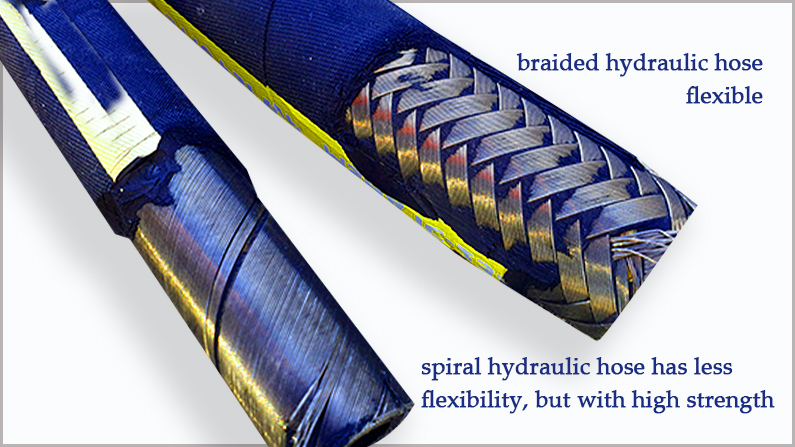
Compared with the braided hydraulic hose, the spiral hydraulic hose has much less flexibility, but with better maximum pressure capacity. So that you can use the spiral hydraulic hose for the heavy-duty machine due to the spiral hose’s high strength.
Both of these two hydraulic hoses are manufactured with certain functions, and you only need to choose the suitable hydraulic hose for your hydraulic system, making it work better for your hydraulic project.
Here are differences between spiral and braided hydraulic hoses:
| Aspect | Braided Hydraulic Hose | Spiral Hydraulic Hose |
|---|---|---|
| Design | Braid-like pattern with alternating steel wires. | Spiral-like pattern with parallel steel wires. |
| Ease of Production | Requires heavy machinery for production. | Relatively easier and faster to manufacture. |
| Strength | High tensile strength due to interlocking wires. | Requires more spiral wires for pressure resistance. |
| Application | Suited for high-tensile strength applications. | Ideal for high-pressure applications. |
| Flexibility | Relatively flexible. | Relatively rigid. |
| Bend Radius | Tighter bend radius. | Highly resistant to bending. |
| Popularity | More common in hydraulic applications. | Less common in hydraulic applications. |
| Adaptability | Works in small spaces with tighter bend radius. | Not suitable for space-limited applications. |
This table should help provide a clear overview of the differences between spiral and braided hydraulic hoses.
What is the Difference Between Spiral and Braided Reinforcement?
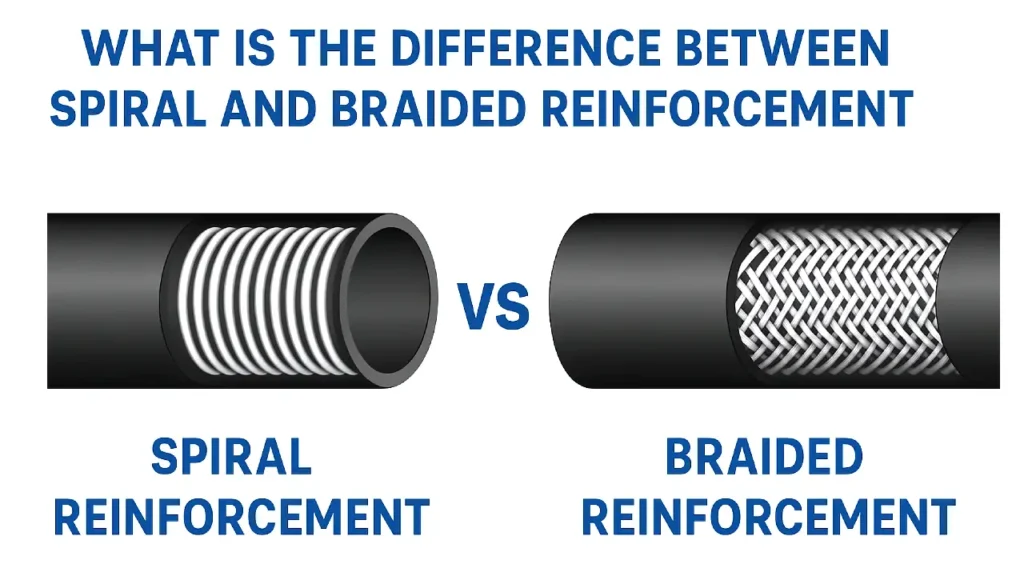
The main difference between spiral and braided reinforcement lies in their structural design and how they provide strength to hoses:
Braided Reinforcement:
- Design: Braided reinforcement consists of steel wires arranged in an interlocking, crisscross pattern around the inner tube of the hose.
- Strength: The interlocking design of the steel wires provides high tensile strength to the hose. This design helps the hose withstand internal and external pressures.
- Flexibility: Braided reinforcement offers relative flexibility, allowing the hose to bend and move more easily.
- Applications: Braided reinforcement is suitable for applications that require high tensile strength, such as industrial and hydraulic systems. It is commonly used in medium-pressure hoses.
Spiral Reinforcement:
- Design: Spiral reinforcement involves steel wires arranged in a parallel spiral pattern around the inner tube of the hose.
- Strength: The parallel spiral arrangement of steel wires provides greater structural integrity, enabling the hose to handle higher pressures and resist collapsing under suction.
- Rigidity: Spiral reinforcement results in a relatively rigid hose structure, making it less flexible than braided hoses.
- Applications: Spiral reinforcement is ideal for high-pressure applications, such as heavy machinery, construction equipment, and applications where suction resistance is essential.
In a word, braided reinforcement offers flexibility and is suitable for applications requiring moderate strength, while spiral reinforcement provides increased strength and is better suited for high-pressure and suction-resistant applications. The choice between the two depends on the specific requirements of the application and the level of pressure the hose needs to withstand.
Braided Hydraulic Hose or Spiral, Which is Better?
Choosing between braided and spiral hydraulic hoses depends on your system requirements, including pressure, flexibility, and application environment. Each hose type has advantages: spiral hoses excel under high pressure, while braided hoses offer superior flexibility. Understanding these differences ensures optimal performance, safety, and long-term reliability in hydraulic systems.
- Pressure Handling: Spiral hoses are better suited for extremely high-pressure applications, providing maximum strength and safety. Braided hoses handle moderate pressures effectively but may not withstand extreme loads, making spiral hoses the preferred choice for heavy-duty industrial and construction hydraulic systems.
- Flexibility: Braided hoses offer greater flexibility, making them ideal for tight spaces, complex machinery layouts, and frequent movement. Spiral hoses are less flexible due to their tightly wound steel layers, requiring careful installation and limiting bending in confined systems.
- Durability: Spiral hoses are highly durable and resistant to abrasion, high pressure, and environmental factors, ensuring long service life. Braided hoses are durable for moderate conditions but may experience fatigue faster under continuous high-pressure operation.
- Installation and Maintenance: Braided hoses are easier to install in intricate systems due to their flexibility. Spiral hoses require precise routing and careful handling to avoid kinks or damage, but they provide long-term reliability once installed correctly.
- Applications: Spiral hoses are ideal for heavy industrial machinery, construction equipment, and hydraulic systems requiring maximum pressure tolerance. Braided hoses are suitable for automotive, mobile equipment, and moderate-pressure hydraulic systems where ease of routing and flexibility are priorities.
Conclusion
In conclusion, spiral and braided hydraulic hoses each have distinct advantages and applications. Spiral hoses excel in high-pressure, heavy-duty environments, providing superior strength and long-term durability. Braided hoses, on the other hand, offer flexibility and easier handling, making them suitable for less demanding but precise hydraulic applications.
Choosing the right hydraulic hose depends on your system requirements, including pressure, temperature, and installation constraints. Spiral hoses are ideal for demanding industrial and construction systems, while braided hoses are perfect for moderate pressure and intricate layouts. Understanding these differences prevents equipment failure and ensures reliable, safe hydraulic system operation.
For businesses and industries seeking hydraulic hoses, Kingdaflex provides wholesale spiral and braided hydraulic hoses. We ensure premium construction, strict quality control, and competitive pricing. Our hoses are designed for long-lasting performance, making us a trusted supplier for industrial, automotive, and commercial hydraulic applications worldwide.

